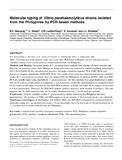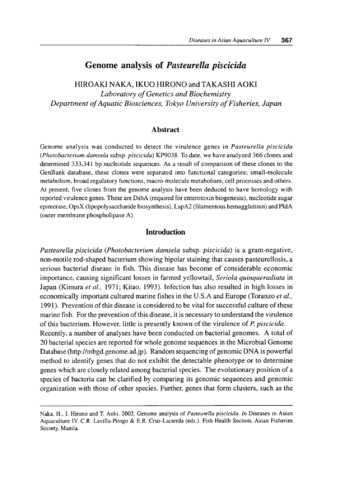Molecular typing of Vibrio parahaemolyticus strains isolated from the Philippines by PCR-based methods
- Global styles
- MLA
- Vancouver
- Elsevier - Harvard
- APA
- Help

View/
Date
2005Page views
1,922ASFA keyword
AGROVOC keyword
Taxonomic term
Metadata
Show full item record
Share
Abstract
Aim: The main aim of the present study was to use three PCR-based techniques for the analysis of genetic variability among Vibrio parahaemolyticus strains isolated from the Philippines.
Methods and Results: Seventeen strains of V. parahaemolyticus isolated from shrimps (Penaeus monodon) and from the environments where these shrimps are being cultivated were analysed by random amplified polymorphic DNA PCR (RAPD-PCR), enterobacterial repetitive intergenic consensus sequence PCR (ERIC-PCR) and repetitive extragenic palindromic PCR (REP-PCR). The results of this work have demonstrated genetic variability within the V. parahaemolyticus strains that were isolated from the Philippines. In addition, RAPD, ERIC and REP-PCR are suitable rapid typing methods for V. parahaemolyticus. All three methods have good discriminative ability and can be used as a rapid means of comparing V. parahaemolyticus strains for epidemiological investigation. Based on the results of this study, we could say that REP-PCR is inferior to RAPD and ERIC-PCR owing to the fact that it is less reproducible. Moreover, the REP-PCR analysis yielded a relatively small number of products. This may suggests that the REP sequences may not be widely distributed in the V. parahaemolyticus genome.
Conclusions: Genetic variability within V. parahaemolyticus strains isolated in the Philippines has been demonstrated. The presence of ERIC and REP sequences in the genome of this bacterial species was confirmed. Significance and Impact of the Study:The RAPD, ERIC and REP-PCR techniques are useful methods for molecular typing of V. parahaemolyticus strains. To our knowledge this is the first study of this kind carried out on V. parahaemolyticus strains isolated from the Philippines.
Suggested Citation
Maluping, R. P., Ravelo, C., Lavilla-Pitogo, C. R., Krovacek, K., & Romalde, J. L. (2005). Molecular typing of Vibrio parahaemolyticus strains isolated from the Philippines by PCR-based methods. Journal of Applied Microbiology , 99(2), 383-391. https://doi.org/10.1111/j.1365-2672.2005.02571.x
Type
ArticleISSN
1364-5072Collections
- Journal Articles [1258]
Related items
Showing items related by title, author, creator and subject.
-
Genome analysis of Pasteurella piscicida
Naka, Hiroaki; Hirono, Ikuo; Aoki, Takashi (Fish Health Section, Asian Fisheries Society, 2002)Genome analysis was conducted to detect the virulence genes in Pasteurella piscicida (Photobacterium damsela subsp. piscicida) KP9038. To date, we have analyzed 366 clones and determined 333,341 bp nucleotide sequences. ... -
Milkfish (Chanos chanos) growth hormone cDNA cloning and mRNA expression in embryos and early larval stages.
de Jesus, Evelyn Grace T.; Ayson, Felix G.; Amemiya, Yutaka; Moriyama, Shunsuke; Hyodo, Susumu; Hirano, Tetsuya; Kawauchi, Hiroshi (Elsevier, 2002)In an attempt to understand growth regulation in milkfish, the milkfish growth hormone (GH) and its cDNA were characterized and the expression of GH mRNA in embryos and larvae was examined by RT-PCR. The milkfish GH was ... -
Morphological and genetic diversity assessment of freshwater prawns (Macrobrachium spp.) in the Cairawan river, Antique province, Panay island, Philippines
Santos, Mary Nia M.; Wowor, Daisy ; Ikeda, Minoru; Padilla, Philip Ian
; Ikeda, Minoru; Padilla, Philip Ian  ; Romana-Eguia, Maria Rowena R.
; Romana-Eguia, Maria Rowena R.  (National Fisheries Research and Development Institute, 2024)
Freshwater prawns of the genus Macrobrachium are among the most valuable cultured aquatic species in the world. The systematic study of Macrobrachium species in the Philippines has often been based on morphological trait ...
(National Fisheries Research and Development Institute, 2024)
Freshwater prawns of the genus Macrobrachium are among the most valuable cultured aquatic species in the world. The systematic study of Macrobrachium species in the Philippines has often been based on morphological trait ...





